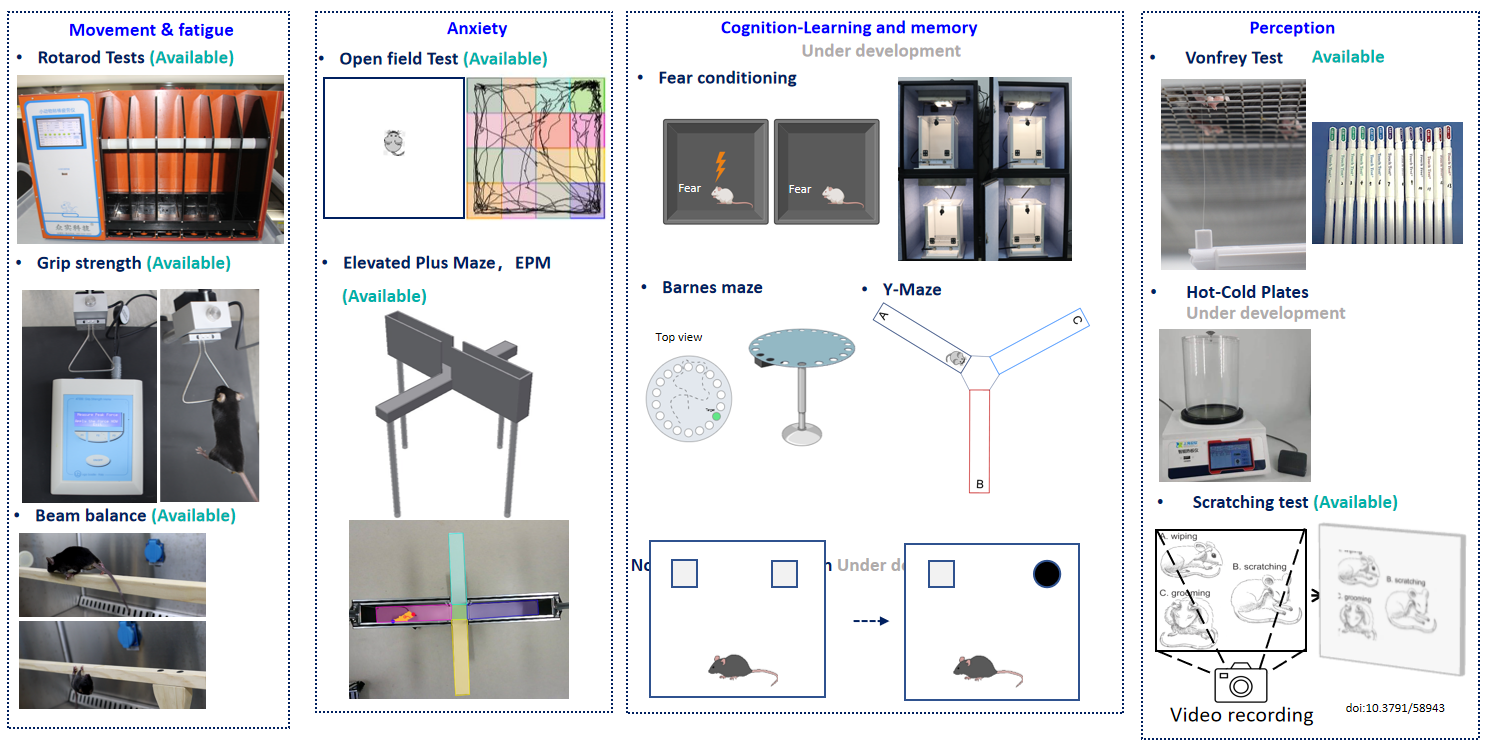

Biocytogen has built a behavioral testing platform, including exercise and fatigue (rotarod , grip strength, beam balance, etc.), anxiety (open field, elevated maze), cognition (fear conditioning, barnes maze, Y-maze, novel object recognition , etc.), and perception (Vonfrey, hot-cold plates, scratching, etc.) tests, which can support preclinical efficacy studies in the fields of neuroscience and brain science.
on this page
Ethology is a discipline that studies the interaction of animals with the environment and other organisms, including animal communication behavior, emotional expression, social behavior, learning behavior, reproductive behavior, etc. Animal behavior experiments are a comprehensive, comprehensive and real-time response to the overall physiological and psychological state of animals, through which researchers can evaluate the physiological and psychological states of animals, so as to explore complex life phenomena such as cognition, emotion and movement. Animal models of diseases are used in many studies, and these animal models of diseases are often combined with animal behavior experiments to explore the pathogenesis, pharmacology, efficacy, etc., so animal behavior experiments have an irreplaceable position and role in the field of biomedicine.
Biocytogen has built a behavioral testing platform, including exercise and fatigue (rotarod , grip strength, beam balance, etc.), anxiety (open field, elevated maze), cognition (fear conditioning, barnes maze, Y-maze, novel object recognition , etc.), and perception (Vonfrey, hot-cold plates, scratching, etc.) tests, which can support preclinical efficacy studies in the fields of neuroscience and brain science.
| Models | Behavior tests |
| Scopolamine induced acute/chronic amnesia (Alzheimer Disease) | Learning & memory |
| 5xFAD mice (Alzheimer Disease) | Learning & memory |
| B-hSNCA*A53T mice Parkinson Disease | Rotarod & Grip strength |
| MCAO induced Stroke | MNSS Score |
| Experimental autoimmune encephalomyelitis (EAE) | EAE score |
| Pentotetrazole (PTZ) induced acute | Seizure stage |
| CFA induced inflammatory pain | Vonfrey test |
| B6-F10 cell induced cancer pain | Vonfrey Test |
| IL31 induced scratching test | Scratching test |
Note: Blue: Available; Grey: Under development
Special techniques - Dosing routes:

The rotarod test is widely used to evaluate the rodent's motor coordination, balance, fatigue level, etc. Animal is placed on a horizontal rod that rotates about its long axis, the animal must walk forwards to remain upright and not fall off. rotarod test is especially sensitive in detecting cerebellar dysfunction or drug induced sedation, anesthesia and muscle relaxant.
| Group | Training Scheme | Testing Scheme |
| G1 | a. Two days before test, each day: 10rpm*5 min + 35 rpm*5 min | A. 5rpm*1min→3rpm/min acc → 40rpm*5min |
| G2 | a. Two days before test, each day: 10rpm*5 min + 35 rpm*5 min | B. 5rpm*1min→8rpm/min acc → 45rpm*1min |
| G3 | b. 1*Day before test: 10rpm*5min*3 | A. 5rpm*1min→3rpm/min acc → 40rpm*5min |
| G4 | b. 1*Day before test: 10rpm*5min*3 | B. 5rpm*1min→8rpm/min acc → 45rpm*1min |
| G5 | c. On the day of test:5rpm*5min | A. 5rpm*1min→3rpm/min acc → 40rpm*5min |
| G6 | c. On the day of test:5rpm*5min | B. 5rpm*1min→8rpm/min acc → 45rpm*1min |

Figure 1. Rotarod test on C57BL/6 mice. Mice receive training and testing scheme according to the table above. Time (A) and total distance (B) on the rods were recorded. Values are expressed as mean ± SEM.

Figure 2. Rotarod test on anaesthetized mice. Mice receive Zoletil®50 and xylazine hydrochloride showed poor running on rods. Total falls at training (A), speed (B) and and total distance (C) on the rods were recorded. Values are expressed as mean ± SEM. One-way ANOVA with Dunnnet's test, *P < 0.05,**P < 0.01 VS control group.